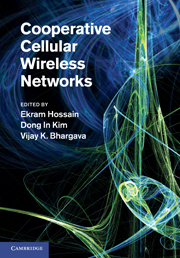Book contents
- Frontmatter
- Contents
- List of contributors
- Preface
- Part I Introduction
- Part II Cooperative base station techniques
- Part III Relay-based cooperative cellular wireless networks
- Part IV Game theoretic models for cooperative cellular wireless networks
- Part V Standardization activities
- 15 Cooperative communications in 3GPP LTE-Advanced standard
- 16 Partial information relaying and relaying in 3GPP LTE
- 17 Coordinated multipoint transmission in LTE-Advanced
- Index
16 - Partial information relaying and relaying in 3GPP LTE
from Part V - Standardization activities
Published online by Cambridge University Press: 03 May 2011
- Frontmatter
- Contents
- List of contributors
- Preface
- Part I Introduction
- Part II Cooperative base station techniques
- Part III Relay-based cooperative cellular wireless networks
- Part IV Game theoretic models for cooperative cellular wireless networks
- Part V Standardization activities
- 15 Cooperative communications in 3GPP LTE-Advanced standard
- 16 Partial information relaying and relaying in 3GPP LTE
- 17 Coordinated multipoint transmission in LTE-Advanced
- Index
Summary
Introduction
Direct transmission from source to destination often faces weaker channel conditions when a mobile is moving across the cell border, because of the large propagation loss due to path-loss and shadowing, and the power limitation not to cause undue interference. For this reason, attention has been given to the use of cooperative relaying to mitigate intercell interference to abtain an increased rate and extended coverage at cell edge.
There have been many proposals for cooperative relaying, such as amplify-and-forward (AF), decode-and-forward (DF), and compress-and-forward (CF), some of which were developed in. Such relaying schemes are mainly designed to exploit the multipath diversity for a power gain (or increased rate) that results from combining direct and relayed signals. However, these schemes do not fully utilize the asymmetric link capacity in direct (source–destination) and relay (source–relay) links, e.g., where the latter gives better results in the downlink if line-of-sight (LoS) transmission is realized in the link between the base station and a fixed relay.
A partial DF protocol has been proposed in that aims to exploit the asymmetric link capacity more efficiently by forwarding a part of the decoded information to the destination using superposition coding. Further, Popovski and de Carvalho investigated a power division between the basic data and the superposed data that result from superposition coding, for a maximum overall rate capacity.
- Type
- Chapter
- Information
- Cooperative Cellular Wireless Networks , pp. 462 - 494Publisher: Cambridge University PressPrint publication year: 2011
- 8
- Cited by

